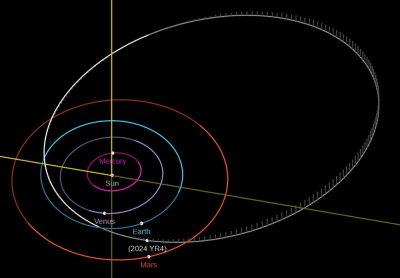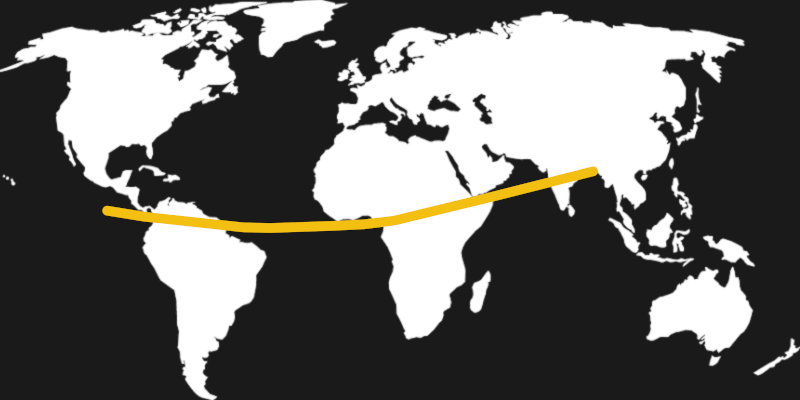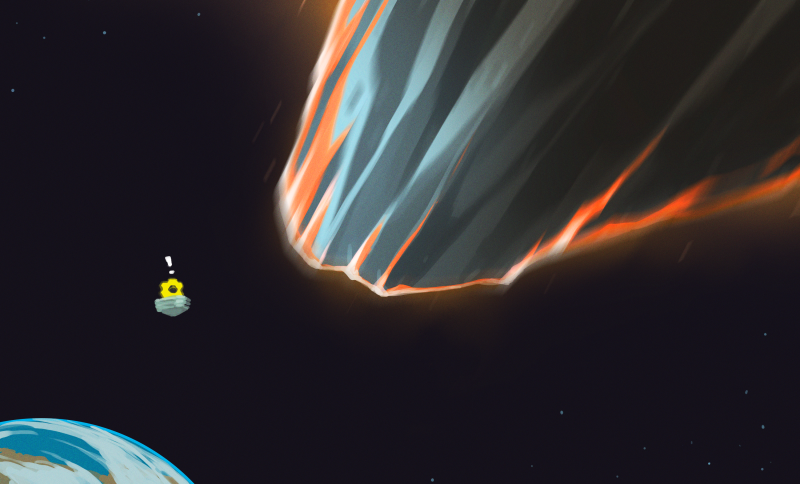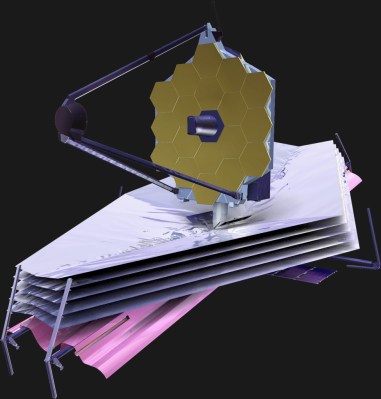In all likelihood, asteroid 2024 YR4 will slip silently past the Earth. Based on the data we have so far, there’s an estimated chance of only 2.1% to 2.3% that it will collide with the planet on December 22nd, 2032. Under normal circumstances, if somebody told you there was a roughly 98% chance of something not happening, you probably wouldn’t give it a second thought. There’s certainly a case to be made that you should feel that way in regards to this particular event — frankly, it’s a lot more likely that some other terrible thing is going to happen to you in the next eight years than it is an asteroid is going to ruin your Christmas party.
That being said, when you consider the scale of the cosmos, a 2+% chance of getting hit is enough to raise some eyebrows. After all, it’s the highest likelihood of an asteroid impact that we’re currently aware of. It’s also troubling that the number has only gone up as further observations of 2024 YR4’s orbit have been made; a few weeks ago, the impact probability was just 1%. Accordingly, NASA has recently announced they’ll be making time in the James Webb Space Telescope’s busy scientific schedule to observe the asteroid next month.
So keeping in mind that we’re still talking about an event that’s statistically unlikely to actually occur, let’s take a look at what we know about 2024 YR4, and how further study and analysis can give us a better idea of what kind of threat we’re dealing with.
An Unexpected Visitor
Officially, 2024 YR4 was discovered on December 27th, 2024 by the Asteroid Terrestrial-impact Last Alert System (ATLAS), but by that time we had already dodged a potential impact. It turns out that the asteroid had come within 828,800 kilometers (515,000 miles), or around two times the distance from the Earth to the Moon, on December 25th without anyone realizing.

All of the observations of the asteroid made since its discovery have therefore been made while the object is moving away from the planet and back into deep space. This is a less than ideal situation when you consider that the asteroid is estimated to be between 40 to 90 meters (130 to 300 ft) in diameter.
With each passing day, it becomes more difficult to track and resolve 2024 YR4, and it’s currently estimated that observing it with ground-based telescopes will no longer be possible beyond April.
That is, until 2028. As you might have put together by now, 2024 YR4 is in such an orbit that it comes within close proximity of Earth every four years. If current orbital projections hold true, during the summer of 2028, the asteroid will be close enough again that we can observe it on the way towards us.
That will include a fly-by of Earth in early December before it swings back out of range. Hopefully by that time we’ll have collected enough data to know whether or not we’ll need to brace for impact the next time it swings by our neighborhood.
Deflect, or Evacuate?
As far as potentially dangerous Near Earth Objects (NEOs) go, 2024 YR4 is about as ideal as they get. While it did sneak up on us in 2024, now we know it’s on a fairly predictable schedule and there’s enough time that we could actually do something about it if the chance of impact gets high enough to take it more seriously. In 2028, we’ve even got a chance to deflect it as it zooms past Earth.
That would have been science fiction a few years ago, but after NASA’s successful DART demonstration mission, we now know it’s possible to significantly alter the orbit of an asteroid simply by ramming a spacecraft into it at high velocity. The target asteroid in that test was much larger than 2024 YR4, with a diameter of 177 meters (581 ft). Yet the head-on impact of the 500 kg (1,100 lb) DART spacecraft was able to slow it down enough to make a noticeable change in its orbit.
Given how close 2024 YR4 would be passing by Earth, it’s not hard to imagine that a spacecraft with several times the mass of DART could be put on a collision course with the asteroid in 2028. Even if such an impact would not be enough to entirely prevent a collision with 2024 YR4, if applied carefully, it could certainly be sufficient to move the calculated point of impact.

But would such a mission even be necessary? Current estimates put around half of the potential impact points for 2024 YR4 over the ocean. Even where the path of the asteroid does cross over land, most of it is sparsely populated. The biggest risks to human life would be in Nigeria and India, but the chances of a direct hit over either area is particularly remote, especially given the estimated blast radius of 50 km (31 miles).
Unless updated orbital data for 2024 YR4 indicates that it’s going to directly impact one of these densely populated areas, the most cost effective approach may be to simply move as many people out of the impact area as possible. While an evacuation of this scale would still be a monumental task, we’d at least have several years to implement the plan.
Bringing Out the Big Guns
While the chances are still excellent that 2024 YR4 will zip harmlessly past our Blue Marble in 2032, it’s not outside the realm of possibility that some big decisions might need to be made in the next few years. So how do we figure out how large of a threat this asteroid really is before it’s too late?
That’s where advanced space-bound observatories like the James Webb Space Telescope (JWST) come in. While our instruments on Earth soon won’t be able to see 2024 YR4, the JWST will not only be able to keep its gaze on the asteroid for longer, but the infrared observatory is uniquely suited for capturing critical data about its size and shape.
Up to this point, the size of 2024 YR4 has been estimated based on its visible appearance, but that can be misleading. It could be that only part of the asteroid is reflective, which would give the impression that its smaller than it actually is. But the JWST doesn’t rely on visible light, and instead can use its IR instruments to detect the heat being given off by the asteroid’s rocky surface.
With definitive data about the asteroid’s size, shape, and rotation, astronomers will be able to better model how 2024 YR4 is moving through space. That’s going to be key to figuring out whether or not that 2.3% chance of impact is going to go up or down — and if it does go up, will help narrow down exactly where the asteroid is likely to hit.

















“2024 YR4’s obit”
Rumors of its demise have been greatly exaggerated
…which could wind up being unfortunate for us.
:) !
Fixed, thanks.
Preserving the blue marble and reaching into the cosmos are not mutually exclusive endeavors.
Poppycock and drivel.
To put this in perspective, if the chances of a huge lottery win were as high as the chances of this asteroid hitting Earth, everybody and his dog would be buying at least one ticket for it. A one-in-fifty chance is not to be taken lightly.
Can confirm: when offered a 1 in 50 chance of a game of fetch, my dog asked when the asteroid was coming.
I’ll be interested to see what we find out and I’m curious how accurately we could adjust orbits.
Maybe some object can be sent on paths that won’t cross us again, some could be adjusted to hit in the ocean, and maybe even very large ones could be sent on a path that would allow for multiple burn ups instead of a giant impact.
That is kind of a worry, if we mess about with an asteroid are we making it more or less likely to hit us next pass, or, worse, slamming it into something else which then will
OMG, you’re right!
Maybe we should contact them, let them know that this is a possibility?
No, even a single intersection is vanishingly rare; if it misses, it won’t line up for another hit on the next pass. It will take an astronomical time-span for the stars to align again, if you don’t mind such phrasing
That would be wayyyyy too much risk. If you have enough advance notice, the thing to do is make it miss Earth completely and hope that Jupiter provides its services as the bouncer of the inner Solar system. If that doesn’t work… Well you’ve bought yourself enough time to make much more ambitious adjustments.
It’s not like it would just run into us again on the next go-around in our orbit. It doesn’t work that way. The periods of the orbits are very dissimilar, and this is not a simple two-body system. One miss would buy us eons, not a single year.
heh I love a good sci-fi plot, but its just that. The US alone spends about 4 billion in food assistance by itself, given to people who have lived on land since the dawn of time and yet still cant figure out how to farm it.
Then there’s dreamer here thinking we can just plop some pod’s mars and save humanity, when in reality its a enormous task just getting a basic payload anywhere close.
Beyond you? LOL no crap you have no realistic grasp of the basic problem
“…The 2024 Farm Bill is estimated to cost $1,364 billion over 10 years…” which translates into ~ $136+ billion PER YEAR.
Most of it, in form of “supporting small- and middle-sized farms” goes straight into the pockets of the megamonsters like Kraft or Conagra Because not a lot of farmers can afford their own farmland, and some had to cede it to the said Microsofts of the farmland so they will rent it back.
I personally heard stories of The Amish (in PA) who were basically threatened into “selling” their own land for pennies to some kind of “investors”, who were nothing but conman reselling the same land to the Conagras and Krafts, who, in turn, would “rent” or “mortgage” (depending how rich the congregation is) to the ex-owners of the land. True story form one of the family out of many – and I suspect that’s not the only one in the area (Gap, PA). What does said Kraft do? You bet – buys the amish-grown organic stuffs and resells for ten prices as “organically certified” and “locally grown”. Next time you buy “amish-produced”, it should also be labeled “by the amish sweatshops run by the Conagras”.
You can guess where the initial capital for running the sub-legal operation comes from now. $136 billion a year. Lots of dough. We can easily feed and shelter the bottom 90% of the law abiding taxpaying US citizens for that much dough, bypassing the Conagras and the Unlievers and the Krafts, but we won’t.
“Officially, 2024 YR4 was discovered on December 27th, 2004 by the Asteroid Terrestrial-impact Last Alert System (ATLAS)”
Typo. That should read “December 27th, 2024”.
I have an astrophysics degree. I have never spoken to an astrophysicist who took human colonization seriously. People who do take it seriously generally lack an understanding about how unique Earth is in the cosmos and how intricately our bodies have evolved to depend on it. The technologies needed to generate safe energy and protect Earth from space rocks exists today. The technology needed to make Mars permanently habitable to humans does not.
Not YET. And not in my lifetime, or maybe even my grandkids’. But let’s get a start on that, lest we consign our species to eventual but certain death on this rock.
Like we are so awesome that we are worth preserving. We don’t even say hi to one another when passing.
Speak for yourself. I’m worthy.
Can you prove it or are you talking out of your anal orifice?
I think O’Neill cylinders are much more plausible to spread humanity around the solar system than teraforming.
He’s right. Mars has no active core, no magnetosphere, and it has very low gravity compared to Earth. There is no known way you could add atmosphere to it faster than the solar wind would blow it away into space, as presumably happened to its former natural atmosphere.
You’d basically have to turn the whole world into a greenhouse. I’ve seen plenty of interesting science fiction interpretations of this, involving massive bio-engineered “trees” that grow as tall as the Karman line and their canopies intertwine into a massive, translucent membrane that encompasses an entire planet, with symbionic engineered organisms which live in the trees, repairing them and propagating them and defending them from whatever threat might arise in tens of thousands of years. Kaina of the Great Snow Sea by Nihei is a perfect example of this, but he’s not the first to come up with the concept. The Orion’s Arm universe has a couple examples, and of course there are even older ones from the 1970s.
That’s a pipe dream with our current technology, but it doesn’t hurt to dream. We could maybe huddle in habitats like we currently use in Antarctica for a few decades or even centuries, but those habitats are not even close to being self-sustaining and will NOT be stable against eons of cultural evolution, political strife, natural phenomena, etc…
One of the nice things about having a huge open-air biosphere that doesn’t require a hermetic seal, or maintenance, or machines, etc.. is that if anything awful happens, it tends to be relatively local and thus plenty of reservoirs of life escape the calamity merely by distance. We don’t have the technology to create a Mars colony with any appreciable “distance” to escape to. It would be a few rat-holes in frozen, desiccated rock. No hope for “terraforming” without a magnetosphere and more mass. Frozen wasteland where nothing grows outside of your tiny hamlet. Better hope nothing ever goes even slightly wrong (it will, on any appreciable time-span)
https://gogoanime.cloud/watch/kaina-of-the-great-snow-sea-e47?ep=e47_1
Pedro, Pedro, Pedro, Pedro, Pe !
Praticamente il meglio di Santa Fe !
Pedro, Pedro, Pedro, Pedro, Pe !
Fidati di me !
How can the “Potential 2032 Impact Corridor” be such a tidy little thin line?
If the probability of missing the earth entirely is 98%, then how can the impact corridor be so precisely drawn?
The probability will really be pretty much uniform over the entire hemisphere facing the asteroid at the expected arrival time, no?
Scott Manley’s recent two videos on this asteroid explain how they determined the precisely drawn line.
Ah, so the probability density function is not remotely isotropic. It really is a long skinny line, largely dominated by arrival time. Interesting.
2032? who cares! I won’t be here anymore :) (It is called black humor)
If I want to put my washing out and Metoffice UK says there’s a 10% chance it’s gonna rain, it’s almost certainly going to rain.
Let’s face it, this is a UK-specific problem though 😂 😭
The rest of the world gets climate, we get weather.
I read a different article that suggests there’s a chance the asteroid might hit the moon instead of the Earth
That’s also a possibility though with a smaller probability given what we now know. The potential line of impacts on the Moon are on its Earthward face so it’ll be a good show if it does occur. Start hoarding popcorn now !!
And toilet paper. My God, if Covid taught us nothing else, it’s to always hoard TP.
Hmm. Hard rain. And Neil deDrasse Tyson will be around to narrate it, no doubt.
(a Seven Eves reference obscure enough to warrant this sentence. )
My mind went there, too. Fortunately, this thing has far less mass than The Agent.
I’ll enjoy it on mute then, that guy is a joke
Ain’t that the truth!
Tyson has lost all credibility in the science world.
Nuf said….
The technology already exists to deflect any asteroid type or comet – surface vaporization/spalling from a standoff nuclear detonation or series of detonations at an appropriate distance for the object to be deflected. An existing warhead could be used, but the control electronics and, perhaps, the conventional explosives used for implosion would have to be tested to simulate long duration flight in deep space. Plus, an international treaty would be needed to allow it.
Asteroid Deflection via Standoff Nuclear Explosions – 2008
https://www.adrc.iastate.edu/files/2015/02/Aaron-Miles.pdf
Protecting Earth from Asteroid Impacts
Sandia National Labs
Nov 21, 2024
At Sandia National Laboratories, scientists are harnessing the power of the Z Machine — the largest pulsed power device on Earth — to explore innovative ways to deflect asteroids.
In a series of groundbreaking experiments, researchers simulate the effects of a nuclear burst aimed at diverting these massive space rocks. By unleashing an intense flash of x-rays on mock asteroids, they have achieved a remarkable milestone: the first experimental confirmation that we can indeed change the course of kilometer-sized asteroids in space.
This animation showcases the cutting-edge technology and research that could one day help safeguard our planet from catastrophic asteroid collisions.
https://www.youtube.com/watch?v=a–_f92O1Nw
Where did it come from?
Did it do a fly-by in 2016 and everyone missed it?
Just curious….
If you think we have a complete catalogue of all Earth-crossers, even ones that have been near our orbit for a thousand years… Hoooo boy we sure don’t. Jupiter does a decent job at kicking them out, but we discover new ones all the time. Including very sizeable ones.
If we do get a big hit from a space object it will loft massive amounts of matter into the stratosphere and drop solar power production below 20% for years too. Civilisation has become far more fragile in recent decades, that is not what I call “progress”.
You’re worried about solar panels?? lol they will drop under fifty percent in five years anyway. My God man.
Civilization has become more “fragile” for reasons you wouldn’t even recognize, but we will be okay and “progress” belongs in the dirt.
Hope we don’t get forced to face reality before then… That is the point, can’t predict when even if the eventual odds are 100%.
Imagine a bronze-age culture with inherited knowledge of nuclear weapons, rebuilding project Orion after they are unbound from this modern hospice-care civilization… Bold Odysseus encountering mythical beings on Europa.